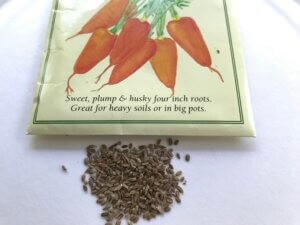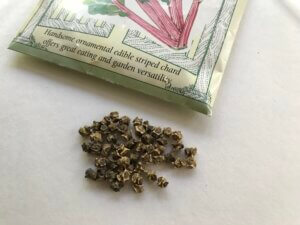Storing Leftover Garden Seed
If you didn’t use up all the garden seed you bought this year, much of it can be stored for use in next year’s garden – depending on the plant species. Seeds of some plants ,such as corn, parsley, onion, viola (pansies), verbena, phlox, and salvia, are not very long lived, lasting only 1 or 2 years at best. Other seeds, including beans, carrots, lettuce, peas, radishes, snapdragon, cosmos, sweet William, and zinnia, will remain viable (capable of germinating) for 3-5 years.
Seeds need to be kept cool, dark, and dry so that they retain stored carbohydrates and minimize fungal infection. You can keep the seeds in their original packets to preserve their labeling information. If you transfer the seeds to another container, be sure to label them with at least the plant name and the year the seed was purchased. Either way, be sure the seed is as dry as possible before placing in storage.
One of the more practical methods for storing small quantities is to place leftover seed in sealable jars or other airtight containers and store in a cool, dark area, such as the refrigerator (not the freezer). A layer of powdered milk or uncooked rice at the bottom of the container will absorb excess moisture. Use a paper towel to separate the seed from the absorptive material.
When it’s time to plant next season, you can do a germination test on a few seeds to see if they sprout before you plant the rest. But these days, many seed packets have only a few seeds to begin with, so the germination test may be a moot point! On the other hand, saving even a few seeds can make a big impact on next year’s gardening budget.
The following chart listing storage life for common garden species will help you decide which seeds are worth the bother. However, the conditions the seeds are stored in dramatically affects how well they will germinate next year, as much or more so than their species.
| Plant | Expected Storage Life (Years) Under Favorable Conditions |
| Vegetables | |
| bean | 3 |
| beet | 4 |
| carrot | 3 |
| chard, Swiss | 4 |
| corn, sweet | 2 |
| cucumber | 5 |
| kohlrabi | 3 |
| lettuce | 6 |
| muskmelon | 5 |
| okra | 2 |
| onion | 1 |
| parsnip | 1 |
| pea | 3 |
| pepper | 2 |
| pumpkin | 4 |
| radish | 5 |
| spinach | 3 |
| squash | 3 |
| tomato | 4 |
| turnip | 4 |
| watermelon | 4 |
| Annual Flowers | |
| ageratum | 4 |
| alyssum | 4 |
| aster | 1 |
| calendula | 5 |
| celosia | 4 |
| coleus | 1 |
| cosmos | 3 |
| dahlia | 2 |
| dianthus | 4 |
| geranium | 1 |
| hibiscus | 3 |
| hollyhock | 2 |
| impatiens | 2 |
| lobelia | 3 |
| marigold | 2 |
| nasturtium | 5 |
| nicotiana | 3 |
| pansy | 1 |
| petunia | 2 |
| phlox | 1 |
| poppy | 4 |
| salvia | 1 |
| verbena | 1 |
| vinca | 1 |
| zinnia | 5 |
Yard & Garden Calendar – October 2020
HOME (Indoor plants and activities)
Keep poinsettia in complete darkness for 15 hours each day — for example, between 5 p.m. and 8 a.m. — for eight to 10 weeks until red bracts begin to show.
Pot spring-flowering bulbs to force into bloom indoors. Moisten soil and refrigerate 10 to 13 weeks. Transfer to a cool, sunny location, and allow an additional three to four weeks for blooming.
Houseplants, especially those grown outdoors during the summer, commonly drop some or many of their leaves in response to the lower natural light intensity in the autumn and reduced light intensity indoors.
Water indoor plants less frequently, and discontinue fertilizer as plants slow down or stop growing for the winter season.
YARD (Lawns, woody ornamentals and fruits)
Keep plants, especially newly planted stock, well-watered until ground freezes.
Have soil ready to mound roses for winter protection. Do not mound or cover roses until after leaves drop and soil is near freezing, usually late November or early December.
Strawberry plants need protection from winter’s extremes, but applying winter mulch too early may cause crowns to rot. Apply winter protection when plants are dormant but before temperatures drop below 20F, usually late November or early December.
Rake or shred large, fallen tree leaves, such as maple, to prevent them from matting down and smothering grass. Raking smaller leaves, such as honey locust, is optional.
Continue mowing lawn as needed.
GARDEN (Flowers, vegetables and small fruits)
Harvest root crops and store in a cold (32 F), humid location. Storing produce in perforated plastic bags is a convenient, easy way to increase humidity.
Harvest brussels sprouts as they develop in the axils of the leaves from the bottom of the stem. Brussels sprouts will continue to develop up the stem.
Harvest pumpkins and winter squash before frost, but when rind is hard and fully colored. Store in a cool location until ready to use.
Harvest gourds when stems begin to brown and dry. Cure at 70-80 F for two to four weeks.
Harvest mature, green tomatoes before frost and ripen indoors in the dark. Warmer temperatures lead to faster ripening.
Asparagus top growth should not be removed until foliage yellows. Let foliage stand over winter to collect snow for insulation and moisture.
Remove plant debris from the garden to protect next year’s plantings from insect and disease buildup. Compost plant refuse by alternating layers of soil, plant material, and manure or commercial fertilizer.
Have garden soil tested for fertilizer needs every three to five years.
Incorporate organic matter in fall to avoid the rush of garden activities and waterlogged soil in spring. Soils prepared in the fall tend to warm faster and allow earlier planting in spring.
Dig tender garden flower bulbs for winter storage. Gladiolus corms should be dug when leaves begin turning yellow. Caladiums, geraniums and tuberous begonias should be lifted before killing frost. Dig canna and dahlia roots after a heavy frost. Allow to air dry, then pack in dry peat moss or vermiculite, and store in a cool location.
Complete planting of spring-flowering bulbs.

